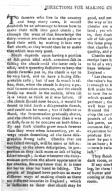[ Directions for Making Cheese ]
Date: 1791/03/01
Source:
Nova Scotia Magazine
Institution: Nova Scotia Archives
| Source Origin: Nova Scotia Newspapers on Microfilm
| Reference: Microfilm Reels 8062, 8063
A discussion of the importance of salting cheese properly followed by a recipe for making it. Vol. 4. (March 1791) nn.84. Microfilm Reel 8063.
DIRECTIONS FOR MAKING CHEESE.
TO farmers who live in the country
and keep many cows, it would
doubtless be an advantage to know how to
make their milk into good cheese; for
through the want of that knowledge the
dairy-women are often as much pains to
spoil their milk by making it into very
bad cheese, as they would then be to make
that which was very good.
Much depends upon having a portion
of salt-petre used with common salt in
salting the cheese:--If the latter only is
used, and a quantity sufficient to keep the
cheese sweet is put in, the cheese is apt to
be very hard, and to have a biting disa-
greeable taste; but if not so much is ta-
ken, then, when the cheese is drying a pu-
trid fermentation comes on, and the cheese
swells up much in the middle, often till
it is twice as thick as it was before. If
the cheese should now be cut, it would be
found to send forth a disagreeable stench,
and could not be eaten; but if suffered to
stand, the fermentation gradually abates,
and the cheese falls, even lower than it was
at first, so as to be concave on both sides:
By age such cheeses grow much sweeter
than they were when fermenting, yet al-
ways retain something of the same disa-
greeable strong taste. Cheeses that are
not salted enough, will be more or less ac-
cording to the above description, in pro-
portion as they lack more or less of being
salted enough; so that whenever the dairy-
woman perceives the above appearance in
her cheeses, she may know that it is time
for her to alter her hand in salting. The
people of England have perhaps as many
different ways of making cheese as there
are different counties in England; which
is sufficient to shew that cheese may be
___
good, and yet differ in some respects as to
the way of its being made; for the best of
cheeses are made in divers parts of Eng-
land; yet whatever particulars they differ
in, they doubtless agree in adopting the
use of salt-petre, though perhaps not all in
the same proportion; for it is well known
that cheeses from different parts vary in
quality, and yet are all very good.
Cheese made according to the following
receipt have by long experience been found
to be of a very excellent quality, and per-
haps inferior to none that are made in
England:
‘Let the runnet be prepared by soaking
the calve’s bag in cold water, and salting
it enough to keep it sweet; to the milk,
first made blood warm, add enough of this
to turn the milk to a curd in half an hour,
which the quantity will soon be found by ex-
perience; then heat it as hot as you can
well bear your hand in it, and having
strained the whey well from it, break or
chop the curd to pieces, and to every five
pounds of cheese put a tea spoonful of
salt-petre, and a large table spoonful of
common salt; (it will soon be learned by
experience how much milk or curd will
produce five pounds of cheese) it must
now be put in the press and turned with-
in an hour; keep it in the press two days,
--turn it twice the first day, and once the
last.’
They should while drying be kept in a
dark room, or otherways kept from flies.
If any cracks come in them when dry-
ing, let them be filled with a paste made
of butter and flour to keep the flies from
coming at them, if any should get into the
room.
Download: Transcription | Images
